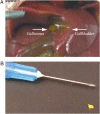Gallstones play a significant role in Salmonella spp. gallbladder colonization and carriage
- PMID: 20176950
- PMCID: PMC2840110
- DOI: 10.1073/pnas.1000862107
Gallstones play a significant role in Salmonella spp. gallbladder colonization and carriage
Abstract
Salmonella enterica serovar Typhi can colonize the gallbladder and persist in an asymptomatic carrier state that is frequently associated with the presence of gallstones. We have shown that salmonellae form bile-mediated biofilms on human gallstones and cholesterol-coated surfaces in vitro. Here, we test the hypothesis that biofilms on cholesterol gallbladder stones facilitate typhoid carriage in mice and men. Naturally resistant (Nramp1(+/+)) mice fed a lithogenic diet developed cholesterol gallstones that supported biofilm formation during persistent serovar Typhimurium infection and, as a result, demonstrated enhanced fecal shedding and enhanced colonization of gallbladder tissue and bile. In typhoid endemic Mexico City, 5% of enrolled cholelithiasis patients carried serovar Typhi, and bacterial biofilms could be visualized on gallstones from these carriers whereas significant biofilms were not detected on gallstones from Escherichia coli infected gallbladders. These findings offer direct evidence that gallstone biofilms occur in humans and mice, which facilitate gallbladder colonization and shedding.
Conflict of interest statement
The authors declare no conflict of interest.
Figures






References
-
- Rabsch W, Tschäpe H, Bäumler AJ. Non-typhoidal salmonellosis: Emerging problems. Microbes Infect. 2001;3:237–247. - PubMed
-
- Tsolis RM, Young GM, Solnick JV, Bäumler AJ. From bench to bedside: Stealth of enteroinvasive pathogens. Nat Rev Microbiol. 2008;6:883–892. - PubMed
-
- Butler T, Bell WR, Levin J, Linh NN, Arnold K. Typhoid fever. Studies of blood coagulation, bacteremia, and endotoxemia. Arch Intern Med. 1978;138:407–410. - PubMed
Publication types
MeSH terms
Substances
Grants and funding
LinkOut - more resources
Full Text Sources
Other Literature Sources
Molecular Biology Databases
Miscellaneous

